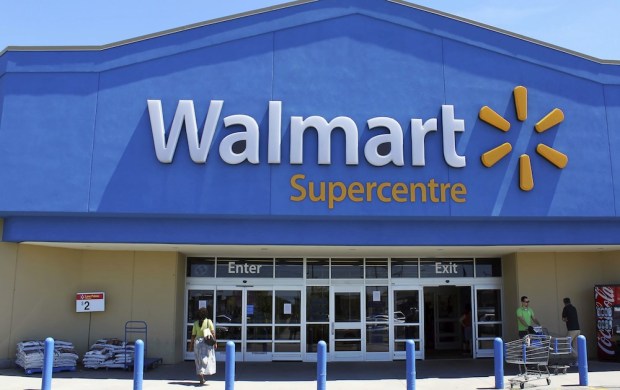Walmart Brings The Pricing Pain (Watch Out Kroger)

Walmart is launching a new price-comparison test in about 1,200 of its U.S. retail locations as it moves to try and close the pricing gap with rival grocery peddlers (like Kroger) and discounters (like Aldi). The move is widely expected to put pressure on packaged good suppliers.
The test ranges across 11 states located in the Midwest and South and is squarley aimed and finding and setting new price points for a range of products it sells under its grocery banners. Currently about 56 percent of Walmart’s sales come via its grocery business.
And, according to first-hand observation by Reuters reporters in Iowa and Illinois, the price changes are alraedy going into effect. Reuters reports that Walmart’s prices were consistently lower than Aldi’s — a switch from recent analyst estimates that clocked Walmart’s prices as being 20 percent higher than Aldi’s on average across grocery staples.
Staples that are now in a race for the bottom, according to reports — eggs in both stores were now less than a dollar for a dozen while milk prices were as low as $1 a gallon.
And Walmart is playing hardball with suppliers — the world’s largest retailer by sales had a meeting in Arkansas last week with food and consumer products vendors at which they more or less demanded that they reduce the cost they charge the retailer by 15 percent, sources said. And these are big firms Walmart is making demands of — Procter & Gamble, Unilever, Conagra Brands, Kraft/Heinz and Johnson&Johnson were all part of the meeting. As of yet, none of the involved brands have any official comment to offer.
The expectation — according to reports — is that suppliers are going to help Walmart win a head-to-head pricing match-up 80 percent of the time.
The price re-centering has reportedly been in the works for at least a year — though when asked directly about either the price test or the demands on its suppliers, Walmart had no official comment to offer.
Walmart spokesman Lorenzo Lopez said the company is “not in a position to share our strategy for competitive reasons.”
A pricing punch-out with Aldi and the other hoards of players in U.S. grocery sales could be costly for Walmart. According to Scott Mushkin, managing director of Wolfe Research and a leading pricing analyst, the retailer could be looking at spending as much as $6 billion to regain market share from all of its grocery rivals.
Plus, those cuts can’t eat too much into Walmart’s already shrinking margins — in Q4 2016 the retailer saw its gross margins take an 8 basis points hit, while net income dropped 18 percent compared to the year-ago quarter. The company attributed the decline to factors such as price investments, which is essentially the cost of cutting prices.
Vendors said Walmart has told them it intends to maintain margins on average and lose money on some goods as part of its pricing plan and that it will absorb some of the losses so suppliers can adjust to the new pricing demand.
One supplier noted that his company’s products had declined in price by as much as 30 percent in some stores over the past few months.
“It helped them figure out the sweet spot that drives traffic,” the person said.
Walmart also said it wants vendors to make logistics improvements that would help vendors get $1 billion more in sales, and that they work harder on shipping orders in full and on-time, which would trim delivery costs, reduce re-orders, and reduce out-of-stock problems.
“Wal-Mart is trying to go back to where they were 10 years ago when they were absolutely the low price leader,” a large packaged food supplier told Reuters on condition of anonymity. “We understand they are willing to give up profits to a large extent in some cases, so they can invest in their own brand.”
Aldi and Kroger declined to comment on the story.
